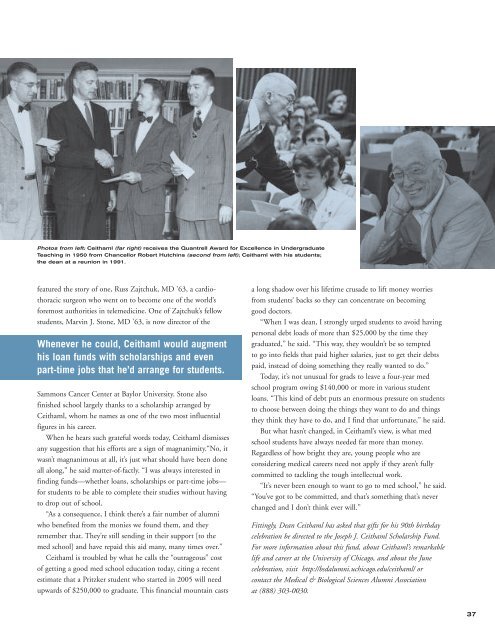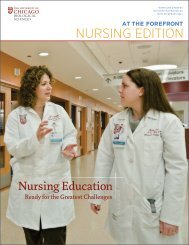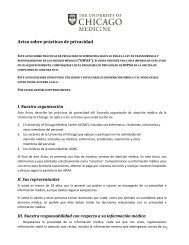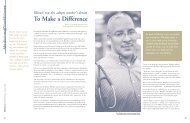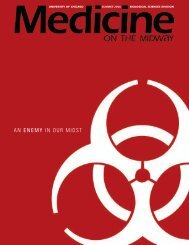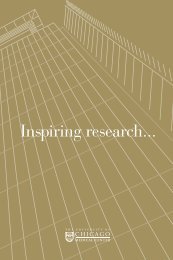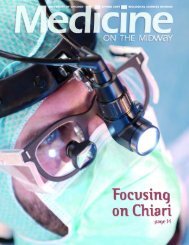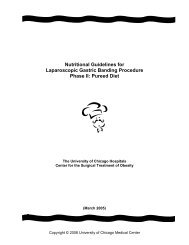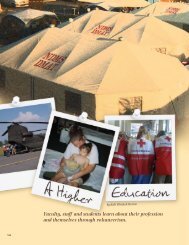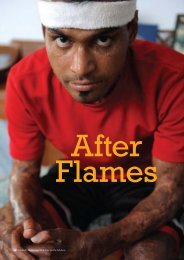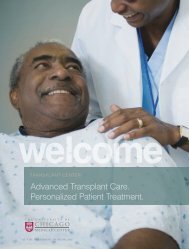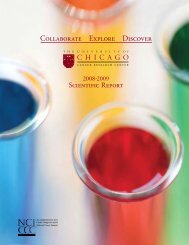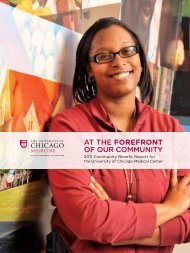Photo by Dan DryMedicineoff theMidwaySusan Shumway, MD ’60, now a retired pediatrician in Encino,Calif., fondly recalled her first encounter with Dean Joe. “He spokewith the students, not at us, and he always spoke from the heart,”she said. “I think many times, he knew more about what we reallyneeded than we knew ourselves. You could go to him with anyproblem you might be having and he was very reassuring, verycompassionate.”Martin “Marty” Pops, MD ’64, not only credits Ceithaml withhis medical training, but his career that took a similar path. Whilefinishing his training in psychiatry at University of California-LosAngeles, Pops found himself at the same crossroad Ceithaml had facedin 1950—to stay in administrative work or pursue a career in research.An anguished Pops sat down with Ceithaml at a professional meetingand revealed his dilemma.“He told me, ‘Marty, if you want to commit academic suicide,you might not want to [take the administrative job]. Because ifyou do, and do it right, you’re just not going to have much timeto do anything else,’” Pops recalled.Now retired in Los Angeles, Pops went on to spend 31 years onthe UCLA faculty, stepping down as dean of students for its medschool in 1996. He said that it was a rare day in his long career asdean that he didn’t reflect on how Joe Ceithaml would have handleda particular situation.“Over the years, I’d see Joe at professional meetings, and he’dalways say it was the students who made him look good,” Popssaid. “He was always thinking about the students, about how theyneeded to learn to take the focus off themselves and put the focuson patients. He taughtus that this should beour guiding principle.”As for Ceithaml’sfamous influence overstudents’ lives atChicago, Pops hadheard rumors evenbefore he applied foradmission. He soonlearned just how muchon the mark thoserumors were.Applying fairly late inthe admissions pipelinefor the entering class of1960, Pops interviewedwith Ceithaml on aSaturday morning beforehopping a plane to Cleveland to visit some family members.Ceithaml had concluded the interview by saying he’d have to runPops’ application by the school’s admissions committee. PopsJoe Ceithaml with his second wife, Mildred,whom he married in 1989. He also has twochildren: Lenore, who practices immigrationlaw in San Diego, and Eric, chief of pediatriccardiovascular surgery at the University ofFlorida at Jacksonville.thanked him, gave him the Cleveland address of where he’d bestaying for a few days, and left.When Pops arrived at the Cleveland airport that evening, hewas greeted by a grinning aunt and uncle frantically waving atelegram. It was from Ceithaml, announcing Pops’ acceptancefor the class of 1960. In recounting the tale, Pops chuckled.“There’s no way the admissions committee could have beencalled from the time I’d interviewed that morning,” he said.“This bore home the rumors that it was Joe Ceithaml who madeall the decisions. At the time, I don’t think this was all thatunusual in med schools. But I know that back then at UC,Joe Ceithaml was the admissions committee.”Ceithaml fondly remembers Pops and so many others, evenif their names don’t spring to mind like they once did. Once hecould call the first name of nearly every student on campus. Itwas a trademark characteristic that made each student feel special.“I took my job seriously, but I never took myself all thatseriously,” Ceithaml said with a chuckle. “I like to think of myselfas being as good a dean for students as I was dean of students.”LIFT<strong>IN</strong>G MONEY WORRIESA product of the Depression, the son of a machinist for theBell Telephone Company, Ceithaml instinctively understood howfinancial hardships commonly threatened or doomed altogetherthe med school ambitions of many promising students. One ofthe first items of business he took up upon becoming dean ofstudents was to establish a loan fund to help students in direfinancial need. Ceithaml started with $25,000 in the fund in1952, and by the time he stepped down 35 years later, it hadgrown to more than $6 million.When Ann, his wife of 43 years, died of cancer in 1985, he setup a separate loan fund in her name to honor her for all the yearsshe supported his career. To this day, the fund offers interest-freeloans to qualified students, while the other funds continue to offerlow-interest loans.Whenever he could, Ceithaml would augment his loan funds withscholarships and even part-time jobs that he’d arrange for students.Ed Comay, MD ’57, also a retired Los Angeles psychiatrist,remembers the latter well. Even with support from the G.I. Bill,Comay said he couldn’t make ends meet once he enrolled, so hewent to Ceithaml looking not for a handout but a job. He soonfound himself working part-time in the school’s medical chemical lab.“I got a room in the hospital and a hundred dollars a month,which paid for my meals,” Comay said. “So between this joband the G.I. Bill, that’s how I made it through school.”Ceithaml’s knack for arranging scholarships for worthyrecipients was renowned. Two of the university’s mostdistinguished medical school alumni fully credit a Ceithamlscholarship for their careers. The spring issue of this magazine36
Photos from left: Ceithaml (far right) receives the Quantrell Award for Excellence in UndergraduateTeaching in 1950 from Chancellor Robert Hutchins (second from left); Ceithaml with his students;the dean at a reunion in 1991.featured the story of one, Russ Zajtchuk, MD ’63, a cardiothoracicsurgeon who went on to become one of the world’sforemost authorities in telemedicine. One of Zajtchuk’s fellowstudents, Marvin J. Stone, MD ’63, is now director of theWhenever he could, Ceithaml would augmenthis loan funds with scholarships and evenpart-time jobs that he’d arrange for students.Sammons Cancer Center at Baylor University. Stone alsofinished school largely thanks to a scholarship arranged byCeithaml, whom he names as one of the two most influentialfigures in his career.When he hears such grateful words today, Ceithaml dismissesany suggestion that his efforts are a sign of magnanimity.“No, itwasn’t magnanimous at all, it’s just what should have been doneall along,” he said matter-of-factly. “I was always interested infinding funds—whether loans, scholarships or part-time jobs—for students to be able to complete their studies without havingto drop out of school.“As a consequence, I think there’s a fair number of alumniwho benefited from the monies we found them, and theyremember that. They’re still sending in their support [to themed school] and have repaid this aid many, many times over.”Ceithaml is troubled by what he calls the “outrageous” costof getting a good med school education today, citing a recentestimate that a Pritzker student who started in 2005 will needupwards of $250,000 to graduate. This financial mountain castsa long shadow over his lifetime crusade to lift money worriesfrom students’ backs so they can concentrate on becominggood doctors.“When I was dean, I strongly urged students to avoid havingpersonal debt loads of more than $25,000 by the time theygraduated,” he said. “This way, they wouldn’t be so temptedto go into fields that paid higher salaries, just to get their debtspaid, instead of doing something they really wanted to do.”Today, it’s not unusual for grads to leave a four-year medschool program owing $140,000 or more in various studentloans. “This kind of debt puts an enormous pressure on studentsto choose between doing the things they want to do and thingsthey think they have to do, and I find that unfortunate,” he said.But what hasn’t changed, in Ceithaml’s view, is what medschool students have always needed far more than money.Regardless of how bright they are, young people who areconsidering medical careers need not apply if they aren’t fullycommitted to tackling the tough intellectual work.“It’s never been enough to want to go to med school,” he said.“You’ve got to be committed, and that’s something that’s neverchanged and I don’t think ever will.”Fittingly, Dean Ceithaml has asked that gifts for his 90th birthdaycelebration be directed to the Joseph J. Ceithaml Scholarship Fund.For more information about this fund, about Ceithaml’s remarkablelife and career at the University of Chicago, and about the Junecelebration, visit http://bsdalumni.uchicago.edu/ceithaml/ orcontact the Medical & Biological Sciences Alumni Associationat (888) 303-0030.37


